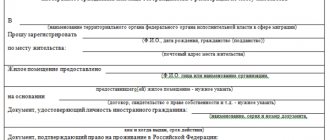The area of the apartment is divided into several categories, the size of which affects many aspects, such as registration of residents, payment of utilities, amount of tax collection, etc. The main legislative framework that regulates this legal area is the Housing Code of the Russian Federation. When signing a share participation agreement, a citizen may also encounter the concept of project area. So, what is included in the living space of an apartment, how the calculation is made and what exactly is affected by an increase or decrease in the established standards - we will consider further.
The legislative framework
Regulatory regulation of the procedure for distributing shares between apartment owners is carried out by the following legal acts:
- Civil Code of the Russian Federation;
- Housing Code of the Russian Federation;
- Federal Law No. 218-FZ “On State Registration of Real Estate”;
- Instructions on the procedure for recording housing stock in the Russian Federation.
It is important to understand that not a single regulatory legal act contains specific options for dividing shares, with the exception of recognizing the equality of rights of the parties to joint property.
Therefore, the fundamental point in resolving disputes between the parties will be the conclusion of a voluntary agreement between them.
Controversial issues of determining the area of premises and calculating fees for housing and communal services
In accordance with the Housing Code of the Russian Federation (hereinafter referred to as the Housing Code of the Russian Federation), the Rules for the provision of utility services (approved by Decree of the Government of the Russian Federation dated 06.06.2011 No. 354, hereinafter referred to as Rules No. 354), the calculation of fees for the maintenance of the common property of the house and fees for individual utilities (hereinafter referred to as payment for housing and communal services) is carried out based on the area of the premises.
However, in practice there are controversial situations in which it is impossible to reliably and unambiguously determine the area of the premises, on the basis of which it is necessary to charge fees for housing and communal services. For example, this may be due to discrepancies in information about the floor area contained in different government information systems.
At the same time, incorrect determination of the area of premises and, accordingly, incorrect calculation of the amount of payment for housing and communal services (especially if it is overstated), creates the risk of filing claims against the management organization, HOA, housing cooperative, other specialized consumer cooperative managing the apartment building, or resource supply organization , supplying utilities directly to the residents of the house (hereinafter referred to collectively as the Management Organizations) on the part of the owners of the premises and authorized authorities. As a result, an order may be issued, unjust enrichment collected, or a fine imposed for violating the rules of management of apartment buildings.
In this regard, this article aims to find out how management organizations should determine the area of premises in disputed situations in order to minimize their risks in the event of claims from premises owners or competent authorities.
So, first, let's look at existing sources of information about the area of premises and the procedure for filling them.
Object one - area three
According to Art. 7 of the Federal Law of July 24, 2007 No. 221-FZ “On the State Real Estate Cadastre” (hereinafter referred to as the Cadastre Law), information on the area is contained in the State Real Estate Cadastre (GKN).
Moreover, information about the area in the State Property Committee is generally entered by a cadastral engineer as a result of measurements of the premises or building in kind.
This provides serious grounds for using information from the State Property Committee as reference information about the area and calculating payments for housing and communal services precisely on the basis of this information, including in any controversial situations.
At the same time, as follows from paragraph 6 of Art. 12 of the Federal Law of July 21, 1997 No. 122-FZ “On state registration of rights to real estate and transactions with it” (hereinafter referred to as the Registration Law), information about the characteristics of a real estate object entered into the State Property Committee is at the same time (reflected) information from the Unified State register of rights to real estate and transactions with it (USRP).
Thus, in the general case, the information from the Unified State Register and the State Property Committee must match.
Considering the above, as well as the fact that the Unified State Register is a key state information resource, it seems that the use of Unified State Register information for the purposes of calculating fees for housing and communal services also looks quite justified.
In addition to the State Property Committee and the Unified State Register of Real Estate, information on the area of real estate in accordance with the Federal Law of July 21, 2014 No. 209-FZ “On the State Information System of Housing and Communal Services” (hereinafter referred to as the Law on the GIS Housing and Communal Services) is contained in the GIS Housing and Communal Services.
According to the Law on GIS Housing and Communal Services (Part 6, Article 7) and the joint order of the Ministry of Telecom and Mass Communications of Russia No. 311 and the Ministry of Construction of Russia No. 612/pr dated August 24, 2015 (clause 5, clause 1), information on the area of real estate is entered into the GIS Housing and Communal Services by Rosreestr, that is, from the Unified State Register or State Property Committee, in which the information must match.
Moreover, the Law on the GIS Housing and Communal Services directly states that the information contained in the GIS Housing and Communal Services is official (clause 2 of Article 9), and therefore , just like information from the State Property Committee or the Unified State Register, can be used for legally binding purposes.
Taking into account the above, we can conclude that:
- information on the area of premises is contained in at least three state information systems - State Property Committee, Unified State Register and GIS Housing and Communal Services;
- the information in each of these systems is of an official nature and can be used for legally significant purposes;
- According to general rules, the information from these systems must match, which explains the lack of legislative regulation of situations where such information does differ.
At the same time, in the practice of Managing Organizations, unfortunately, there are cases of differences in information about the area contained in the systems.
An analysis of the reasons for such a discrepancy is not the subject of this article, so we will only briefly note that this is possible due to errors by government agencies in cases where we are talking about previously recorded property and other situations. Thus, the legislator himself provides for certain cases when Rosreestr for some reason does not enter information about the area into the GIS Housing and Communal Services . From the joint order of the Ministry of Telecom and Mass Communications of Russia No. 74, the Ministry of Construction of Russia No. 114/pr dated 02.29.2016 (including from clause 10) it follows that in cases where information on the area of a real estate property is not entered into the GIS Housing and Communal Services from federal information systems, to which include the Unified State Register and the State Property Committee, such information can be entered by the authorities of the constituent entities of the Russian Federation (first of all, housing registration authorities should be kept in mind here). At the same time, the reliability and legal status of the information at the disposal of housing registration authorities is not regulated by federal legislation.
First among equals. Unified State Register
What should Managing Organizations do in cases of discrepancies in information contained in various official sources?
In accordance with clause 4 of the Rules for the maintenance of common property in an apartment building (approved by Decree of the Government of the Russian Federation of August 13, 2006 No. 491, hereinafter referred to as Rule No. 491), when determining the composition of common property in the event of discrepancies (contradictions) in the information on the composition of common property contained in the Unified State Register, documentation of state technical accounting, accounting of managers or other organizations, technical documentation for an apartment building, the information contained in the Unified State Register has priority.
Despite the fact that the legislation does not establish the priority of information for other cases, it seems appropriate to use the information from the Unified State Register by analogy.
In addition, in a number of court decisions, the courts considered it lawful for the Managing Organization to use precisely the information from the Unified State Register.
In case No. A12-287/2015, the Arbitration Court of the Volga District (see ruling No. F06-1914/2015 dated November 10, 2015) considered the validity of the orders of the housing accounting authority to the management organization regarding the need to recalculate the accrued payment for housing and communal services based on the incorrect area. The housing registration authority, in support of its position, presented a technical passport of the real estate property, in which the area of the property differed from the information of the Unified State Register. The court rejected all claims of the housing registration authority against the management organization, recognizing the use of Unified State Register information as legal.
The legality of using Unified State Register information when calculating fees for housing and communal services is also indicated in the Resolution of the Arbitration Court of the Volga District dated February 25, 2016 No. F06-5633/2016 in case No. A12-27698/2015.
The Khabarovsk Regional Court, in an appeal ruling dated October 15, 2014 in case No. 33-6309/14, considering the case of collection of debt for payment for housing and communal services, rejected all arguments regarding the incorrect determination of the area of the premises on the basis that the plaintiff used information from the Unified State Register to calculate the debt.
These decisions deal with the discrepancy between the information in the Unified State Register and the information in the technical passports. At the same time, no court decisions have been found in which, if there is a discrepancy between information about the area of premises contained in the Unified State Register and information from other sources, the court would be guided by information from other sources.
At the same time, the use of Unified State Register information, of course, does not completely eliminate existing risks. Therefore, if the use of Unified State Register information leads to an overestimation of the payment for housing and communal services (compared to the calculation of payment for housing and communal services based on information from other sources), Managing organizations should take a number of additional measures that could confirm their conscientious behavior.
According to the Registration Law and the Cadastre Law, the elimination of errors in the State Property Committee and the Unified State Register is carried out on the basis of statements from the copyright holder. In this regard, management organizations can send a letter to the owner of the premises with a request to contact Rosreestr to eliminate such discrepancies and information that until the existing inaccuracies are eliminated, fees for housing and communal services will be charged based on the Unified State Register.
In accordance with the Law on GIS Housing and Communal Services, responsibility for entering information into the GIS Housing and Communal Services is assigned to information providers (Article 11), and the Code of Administrative Offenses provides for special responsibility for entering incorrect information into the GIS Housing and Communal Services (Articles 13.19.1 and 13.19.2). Taking this into account, if discrepancies are identified between the information of the GIS Housing and Communal Services and the State Property Committee (or Unified State Register), it is recommended to contact Rosreestr, the Ministry of Construction of Russia and the Prosecutor's Office with a request to bring the information of the State Information System Housing and Communal Services into compliance with the State Property Committee and the Unified State Register.
Taking into account the above, general recommendations in case of discrepancies in information about the area of a real estate property in different government information systems may be as follows:
- when identifying discrepancies in information about the area, be guided by the information from the Unified State Register;
- if there are discrepancies between the information of the Unified State Register and the State Property Committee, it is recommended to send an official letter to the owner with a request to contact Rosreestr to eliminate such discrepancies and information that until the information is clarified in state information systems, fees for housing and communal services will be charged based on the information of the Unified State Register;
- If discrepancies are identified between the information of the Housing Information System and the State Property Committee (or the Unified State Register), it is recommended to contact Rosreestr, the Ministry of Construction of Russia and the prosecutor's office with a request to eliminate the existing inaccuracies.
Total area, term - no
Next, I would like to consider another controversial issue regarding the determination of the area of non-residential premises, on the basis of which fees for housing and communal services should be calculated. We are talking about situations where non-residential premises in apartment buildings (for example, offices) include balconies, terraces, loggias and verandas.
In accordance with Rules No. 354, the calculation of fees for heating and utilities for general house needs is carried out in accordance with the formulas approved in Appendix No. 2 to these Rules.
The formulas given in this appendix for calculating the amount of payment for heating and utilities for general house needs provide for calculating the amount of payment based on the total area of the premises.
However, the legislation defines the total area only in relation to residential premises. So, in accordance with paragraph 5 of Art. 15 of the RF Housing Code, the total area of a residential premises consists of the sum of the area of all parts of the premises, including the area of auxiliary premises intended to satisfy citizens' household and other needs related to their residence in residential premises, with the exception of balconies, loggias, verandas and terraces.
Thus, in the case when the premises of the owner of non-residential premises include balconies, loggias, verandas and terraces, disputes are possible about the size of the area of non-residential premises, on the basis of which fees for housing and communal services should be calculated.
Moreover, the position of the owners making claims is absolutely clear. As stated earlier, the heating fee is calculated based on the total area of the room. That is, when using the full area of non-residential premises for the purpose of charging for housing and communal services, the owners are forced to pay for heating on verandas, loggias, terraces and balconies, which are usually unheated premises.
Despite this, in the clarifications of the Ministry of Economic Development of Russia dated September 17, 2014 No. D23i-3277, it is noted that due to the absence in the legislation of the Russian Federation of the concept of “total area of non-residential premises,” it is recommended to determine the area of non-residential premises in accordance with the order of the Ministry of Economic Development of the Russian Federation dated September 30, 2011 No. 531. B In accordance with this order, the area of the room is determined as the sum of the areas of all parts of such a room, calculated by their sizes, measured between the finished surfaces of walls and partitions at a height of 1.1 - 1.3 meters from the floor.
That is, no exceptions are provided for certain parts of non-residential premises.
Using this method, the area of non-residential premises is determined for entering information into the State Property Committee, which, as noted above, is also information from the Unified State Register.
At the same time, the clarification of the Ministry of Construction of Russia dated November 22, 2012 No. 29433-VK/19 states that the values of the total area of residential premises (apartment), non-residential premises in an apartment building used when calculating the amount of payment for utility services should be determined on the basis of the data contained in the document , confirming the right of ownership (use) of premises in an apartment building, a transfer deed or other document on the transfer by the developer of premises in an apartment building, a technical passport of a residential premises (apartment) or a technical passport of an apartment building.
Thus, the total area of non-residential premises, according to the Russian Ministry of Construction, is considered to be the area indicated as such in the documents available for the premises.
In the appeal ruling of the Ulyanovsk Regional Court dated April 12, 2016 in case No. 33-1332/2016 on the collection of debt for payment of consumed thermal energy, the court, when determining the total area of all residential and non-residential premises of an apartment building, indicated that non-residential premises in an apartment building within the meaning of Rules No. 491 is a premises in an apartment building, which is not residential premises and the common property of the owners of the premises in the apartment building.
For the purpose of considering this case, the court determined the area itself according to the title documents, information from which is contained in the Unified State Register.
Of course, to the situation under consideration with non-residential premises in the event of real proceedings, the court can apply Part 5 of Art. 15 of the RF Housing Code, which establishes the rules for determining the total area of a residential premises, by analogy with the law.
However, at the moment, no such precedents have been published, and the current legislation and clarifications of government bodies do not allow us to conclude that charging fees for housing and communal services based on the area of non-residential premises, including the area of balconies, loggias, verandas and terraces, is contrary to the law (if the area of such parts of the premises is taken into account in the amount of area specified in the Unified State Register and/or State Property Code).
Brief conclusions
Thus, we can conclude the following:
- if the information of the Unified State Register, State Property Committee and State Information System of Housing and Public Utilities differ from each other, then for the purposes of calculating fees for housing and communal services, it is recommended to use the information of the Unified State Register. If the use of Unified State Register information increases the amount of payment for housing and communal services, it is recommended to take additional actions that can confirm the attempts of the Management Organizations to correct existing inaccuracies;
- When calculating the amount of payment for housing and communal services in relation to non-residential premises in apartment buildings, it is recommended to charge the fee based on the area indicated in the Unified State Register or other official documents, including in cases where this area includes balconies, loggias, verandas and terraces.
Agreement on determining shares
The agreement of the parties is the legal basis for allocating a certain share in a shared apartment; it must reflect:
- Date of.
- Information about all parties to the agreement: full name, civil passport details, place of permanent registration.
- Subject of the agreement: how, and in what shares, the common property will be distributed.
- Description of the apartment, its cadastral characteristics.
- The final allocation of specific shares: as a percentage of the entire area of the apartment, one side has so many percentages, the other has so many percentages, and so on for all owners.
- A clause that the shares can be redefined by a separate agreement with the consent of the parties.
- Determination of improvements carried out by the parties both in the entire apartment and in the share: they can be the common property of the parties or a specific owner.
- The owner of the share, at whose expense significant improvements to the apartment were carried out, has the right to count on an increase in the right to common shared ownership.
- If income is received from commercial activities, they can be distributed in accordance with the shares of each owner.
- Limitations on the right of disposal: the second party can dispose of its share only if agreement is reached.
- Determination of the right of first refusal to acquire a share.
- Conditions for terminating the agreement, allocation of a share in kind to each party or compensation in accordance with the shares.
5 years of experience. Specialization: all areas of jurisprudence.
The agreement represents a peaceful option for resolving potential conflicts. The legislator gives users the right to deviate from the principle of equality when drawing up an agreement on the allocation of shares. This means that owners of square meters have the right to independently set arbitrary fractions depending on their needs.
Signatures of the parties to the agreement with transcript. Please note that in order to become the owner of a share under an agreement, it must be registered in the register of individuals, and only from the moment of registration it comes into legal force. If an agreement on determining the shares has not been signed, then they are considered equal.
We suggest you read: How to inherit part of an apartment
5 years of experience. Specialization: all areas of jurisprudence.
If for some reason the users were unable to reach a consensus on concluding an agreement, the subsequent division and allocation of shares from the common real estate is possible only through the courts. It must be remembered that the requirement to allocate separate units of living space is made taking into account certain features.
About the communal apartment
What are the rules for living in a communal apartment and the rights of neighbors?
A communal apartment is a very interesting type of housing to consider. It is an apartment with isolated living rooms, each of which houses a separate family or a single citizen.
At the same time, neighbors are not necessarily related by family or friendly relations.
As noted earlier, geographically such an apartment is divided into two zones:
- common areas - all areas intended for joint use by all residents of the communal apartment (kitchen, bathroom, corridor, etc.);
- The personal possessions of each resident are separate rooms of the apartment that belong to a specific citizen or family.
A communal apartment is not a particularly desirable type of housing, but it is still available in the housing stock of the Russian Federation to this day. These premises can be either municipal in nature, that is, owned by the state and rented out to needy citizens under social rental agreements, or private, that is, they can be privatized and belong to each tenant as property.
What is the total area of the apartment
In the technical passport for an apartment or house you can see the total area of the apartment in numbers. In ordinary everyday life of apartment owners, the total or residential area of the housing does not matter much. But when buying or selling residential real estate, the size of the area affects the cost of the apartment.
The total area (So) is the sum of the areas of all rooms of an apartment or house. It is this indicator that is taken into account when calculating the market and cadastral value of the apartment.
This is exactly the definition that is in effect this year according to the changes in the Russian Housing Code. SNiP and the Housing Code of the Russian Federation have contradictions in some issues. Therefore, in each individual case it is necessary to consult a lawyer.
You can find out whether a balcony and loggia belong to the total area, as well as living space, in this video:
When and why is a common indicator used?
To prevent anyone from violating the rights of the owner of real estate residential property, it is necessary to familiarize yourself with the technical passport of the apartment in advance and carry out the appropriate calculations yourself.
When buying an apartment or selling it, everyone must be in control of the situation and have a clear understanding of which premises cost how much, what their market and cadastral values are, which premises are considered residential and which are auxiliary and on what basis the calculation is carried out using coefficients.
In rental relations, where money also appears, both parties will be more confident in the purity of the transaction if the concepts of the common, living and usable areas of the apartment are clear and easy to understand.
When paying for utilities, in particular heating, it is important to understand the concepts of total living space in order to control bills and prevent errors in receipts and further overpayment for an unheated room. You can find out who is entitled to a subsidy for utility bills here.
Niches whose height exceeds 2 m, as well as under-staircase space over 1.6 m are included in the total area of the apartment.
Which premises are included in the total area and which are not included?
According to the current legislation (the Housing Code of the Russian Federation), from March 1, 2005, the area of an apartment is:
- design;
- residential;
- not suitable for habitation;
- auxiliary (useful);
- total (total).
In addition, heated loggias and balconies, according to changes in the Housing Code of the Russian Federation, have been taken into account in calculations of the total area of the apartment since 2005. From January 1, 2021, the Ministry of Construction and Housing and Public Utilities has clarified the reduction factors for calculating area:
- loggias;
- balconies;
- terraces;
- verandas
Living space
The living area of an apartment is the sum of all living rooms in the property. This information is indicated in Order of the Ministry of Land Construction No. 37 dated 08/04/1998. This regulation also specifies ways to increase the size of the area through other additional premises. For example, you can enlarge a room by adding a corridor or a storage room. To realize this, it is necessary to carry out redevelopment.
So, let's look at two main ways to increase the size of the area:
- Redevelopment.
Any change to the technical plan must have official permission from local governments. It is not worth carrying out any work on the structure without approval, because this is contrary to the law, in particular Article 25 of the RF Housing Code.
- Housing reconstruction.
In this case, not only does the location of doors, windows or walls change, but the area also expands by adding floors, additions, etc. Since this type of work involves impact on load-bearing walls, construction cannot be carried out without special permission.
If the landlord of an apartment building plans such actions, then he is obliged to provide all residents with other housing for the period of construction work. Upon completion of reconstruction, all citizens have the right to return to their previous housing (Article 88 of the Housing Code of the Russian Federation).
Attention! Is the kitchen included in the living area of the apartment? If the owner of the property has made the apartment a studio and the kitchen is connected to a common living space, for example a living room, then it will be considered residential. As for the kitchen, as a separate room, it belongs to the utility room, and is taken into account only in the total area.
Rights and responsibilities of residents of communal apartments
The legislator does not provide a specific set of rules for residents of communal apartments.
All the rights and obligations of citizens sharing a communal apartment are literally scattered across different legislative acts. Having summarized the information from this, we can identify a basic list of rules, rights and responsibilities for all “communal residents”:
- Housing disposal:
- the owner of room(s) in a communal apartment has the right to rent out his housing and register citizens in it;
- The tenant of a room(s) in a communal apartment has the right only to sublease his housing or provide it to other persons free of charge with the consent of the landlord.
- Guests:
- a tenant of any kind (both tenant and owner) has every right to invite guests;
- invited guests have every right to use common areas in the communal apartment;
- Guests must not violate the rights of others living in the apartment and the legislation of the Russian Federation.
- Common areas:
- they are recognized as: corridor, bathroom, hallway and kitchen;
- All residents have the right to occupy such places with their belongings, but only in proportion to their share;
- when using these places, residents do not have the right to litter them or otherwise clutter them;
- common areas are not shared and cannot be sold by an individual resident;
- Maintenance and repairs are carried out by each resident based on the size of his share.








